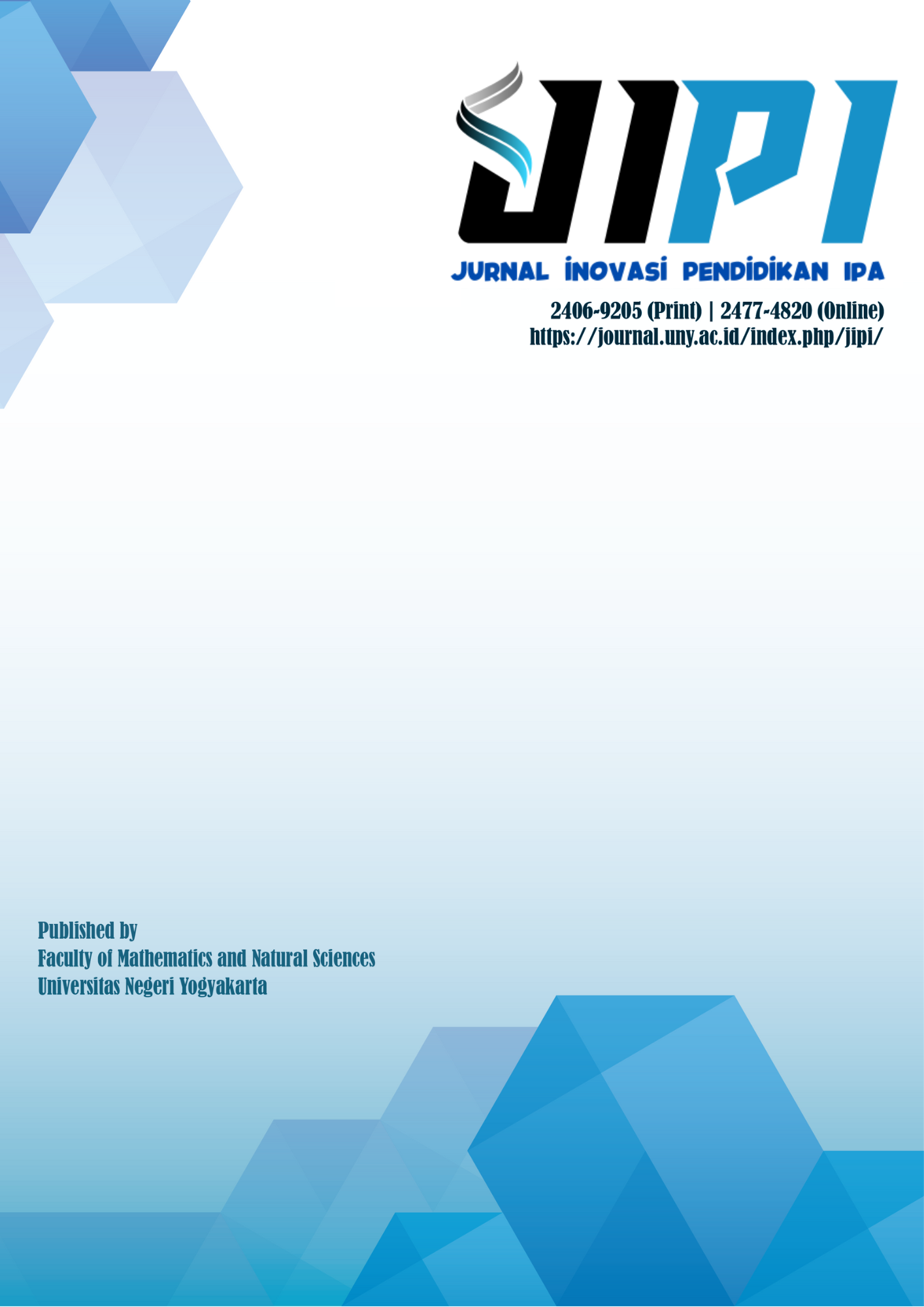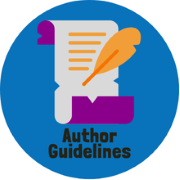Differences between Indonesia and Singapore based on PISA 2015: Five-factor students' perception in science education
DOI:
https://doi.org/10.21831/jipi.v6i1.32637Keywords:
PISA 2015, Students' Perception, Science Education, Different, Indonesia and SingaporeAbstract
As a neighbouring country whose location is very close, there is a unique fact where the results of the PISA study show very different results between Indonesia and Singapore. Students' perceptions of learning have an important role to detect the quality of learning. Thus, this study aims to determine the factors of student perception of natural science learning and the differences between the two countries based on these factors. The sample in this study were 5870 Indonesian students and 5272 Singaporean students who took the 2015 PISA survey. The research data were the results of the PISA survey (codes ST098, ST100, ST103, and ST104) regarding student perception of natural science learning. The data analysis technique used is Principal Component Analysis to detect factors and Discriminant Analysis to show differences between the two countries. Students' perceptions of science learning in Singapore and Indonesia can be classified into five factors: Practicum, Assistant, Explorative, Counseling, and Collaborative. Based on these factors, there are differences in the perception of the implementation of science learning between Indonesian and Singaporean students. Indonesian students tend to be stronger in defining that science learning is full of exploration, collaboration, and teachers play the role of counselor very well, while Singapore students feel more than practical learning based on science and teachers provide student assistance in dealing with difficulties in the learning process.
References
Ahmed, Y., Taha, M. H., Al-Neel, S., & Gaffar, A. M. (2018). Students' perception of the learning environment and its relation to their study year and performance in Sudan. International Journal of Medical Education, 9, 145–150. https://doi.org/10.5116/ijme.5af0.1fee
Arlianty, W. N., Febriana, B. W., & Diniaty, A. (2017). An analysis of learning process based on scientific approach in physical chemsitry experiment. AIP Conference Proceedings, 1823(March), 020084. https://doi.org/10.1063/1.4978157
Bernardo, A. B. I., Limjap, A. A., Prudente, M. S., & Roleda, L. S. (2008). Students ' perceptions of science classes in the Philippines. Asia Pacific Education Review, 9(3), 285–295. https://doi.org/10.1007/BF03026717
Ceylan, E., & Abacı, S. (2013). Differences between Turkey and Finland based on eight latent variables in PISA 2006. International Online Journal of Educational Sciences, 5(1), 10–21. http://www.iojes.net/userfiles/Article/IOJES_1078.pdf
Duda, H. J., Susilo, H., & Newcombe, P. (2019). Enhancing different ethnicity science process skills: Problem-based learning through practicum and authentic assessment. International Journal of Instruction, 12(1), 1207–1222. https://doi.org/10.29333/iji.2019.12177a
Elvanisi, A., Hidayat, S., & Fadillah, E. N. (2018). Analisis keterampilan proses sains siswa sekolah menengah atas. Jurnal Inovasi Pendidikan IPA, 4(20), 245–252. https://doi.org/10.21831/jipi.v4i2.21426
Fenanlampir, A., Batlolona, J. R., & Imelda, I. (2019). The struggle of Indonesian students in the context of TIMSS and PISA has not ended. International Journal of Civil Engineering and Technology, 10(2), 393–406. https://www.iaeme.com/ijciet/IJCIET_Paper.asp?sno=15813
Ganeb, M. D., & Montebon, D. R. T. (2018). Student perception of science as influenced by Spark Science Learning System (SSLS). Acta Didactica Napocensia, 11(1), 87–99. https://doi.org/10.24193/adn.11.1.7
George, D., & Mallery, P. (2006). SPSS for windows step by step a simple guide and reference 13.0 update (6th ed.). Allyn & Bacon.
Green, S. B., Salkind, N. J., & Akey, T. M. (2000). Using SPSS for Windows; analyzing and understanding data. Pearson.
Istiningsih, I. (2016). Character education of the most developed countries in ASEAN. Journal of Education and E-Learning Research, 3(1), 32–37. https://doi.org/10.20448/journal.509/2016.3.1/509.1.32.37
Jacobson, M. J., Levin, J. A., & Kapur, M. (2019). Education as a complex system: Conceptual and methodological implications. Educational Researcher, 48(2), 112–119. https://doi.org/10.3102/0013189X19826958
Kelley, T. R., & Knowles, J. G. (2016). A conceptual framework for integrated STEM education. International Journal of STEM Education, 3(1), 11. https://doi.org/10.1186/s40594-016-0046-z
Kurniawan, W., Darmaji, D., Astalini, A., Kurniawan, D. A., Hidayat, M., Kurniawan, N., & Nur Farida, L. Z. (2019). Multimedia physics practicum reflective material based on problem solving for science process skills. International Journal of Evaluation and Research in Education (IJERE), 8(4), 590. https://doi.org/10.11591/ijere.v8i4.20258
Lau, K., & Lam, T. Y. (2017). Instructional practices and science performance of 10 top-performing regions in PISA 2015. International Journal of Science Education, 39(15), 2128–2149. https://doi.org/10.1080/09500693.2017.1387947
Lisarani, V., Parta, I. N., & Chandra, T. D. (2018). A comparative analysis of the tasks from the selected mathematics textbooks of Singapore and Indonesia. Jurnal Pendidikan Sains, 6(4), 94–99. https://doi.org/10.17977/jps.v6i4.11802
Mayya, S., & Roff, S. (2004). Students' perceptions of educational environment: A comparison of academic achievers and under-achievers at Kasturba Medical College, India. Education for Health: Change in Learning & Practice, 17(3), 280–291. https://doi.org/10.1080/13576280400002445
Ministry of Education. (2013a). Science syllabus. Ministry of Education, Singapore.
Ministry of Education. (2013b). Science syllabus lower secondary: Express course normal (academic) course. Ministry of Education, Singapore.
Organisation for Economic Co-Operation and Development. (2015). Pisa 2015 results in focus.
Organization for Economic Co-operation and Development. (2016a). PISA 2015 top performers. OECD, 1–6. http://ncee.org/wp-content/uploads/2016/12/PISA2015StatvFINAL.pdf
Organization for Economic Co-operation and Development. (2016b). Programme for international student assessment (PISA) results from PISA 2015. OECD, 1–8.
Putri, R. F., & Jumadi, J. (2017). Kemampuan guru fisika dalam menerapkan model-model pembelajaran pada Kurikulum 2013 serta kendala-kendala yang dihadapi. Jurnal Inovasi Pendidikan IPA, 3(2), 201. https://doi.org/10.21831/jipi.v3i2.8636
Retnawati, H., Arlinwibowo, J., Wulandari, N., & Pradani, R. (2018). Teachers' difficulties and strategies in physics teaching and learning that applying mathematics. Journal of Baltic Science Education, 17(1), 120–135. http://www.scientiasocialis.lt/jbse/?q=node/643
Retnawati, H., Munadi, S., Arlinwibowo, J., Wulandari, N., & Sulistyaningsih, E. (2017). Teachers' difficulties in implementing thematic teaching and learning in elementary schools. The New Educational Review, 48(2), 201–212. https://doi.org/10.15804/tner.2017.48.2.16
Sheldrake, R., Mujtaba, T., & Reiss, M. J. (2017). Science teaching and students' attitudes and aspirations: The importance of conveying the applications and relevance of science. International Journal of Educational Research, 85(August), 167–183. https://doi.org/10.1016/j.ijer.2017.08.002
Solikhin, F., Sugiyarto, K. H., & Ikhsan, J. (2019). The impact of virtual laboratory integrated into hybrid learning use on students' achievement. Jurnal Ilmiah Peuradeun, 7(1), 81. https://doi.org/10.26811/peuradeun.v7i1.268
Suprapto, N. (2016). What should educational reform in Indonesia look like? - Learning from the PISA science scores of East-Asian countries and Singapore. Asia-Pacific Forum on Science Learning and Teaching, 17(2), 1–22.
U.S. Department of Education. (2018). National board for professional teaching standards certification. In What Works ClearinghouseTM.
Wang, M.-T. (2012). Educational and career interests in math: A longitudinal examination of the links between classroom environment, motivational beliefs, and interests. Developmental Psychology, 48(6), 1643–1657. https://doi.org/10.1037/a0027247
Yang, D.-C., & Sianturi, I. A. (2017). An analysis of Singaporean versus Indonesian textbooks based on trigonometry content. EURASIA Journal of Mathematics, Science and Technology Education, 13(7), 3829–3848. https://doi.org/10.12973/eurasia.2017.00760a
Yang, D.-C., & Sianturi, I. A. J. (2020). Analysis of algebraic problems intended for elementary graders in Finland, Indonesia, Malaysia, Singapore, and Taiwan. Educational Studies, 00(00), 1–23. https://doi.org/10.1080/03055698.2020.1740977
Downloads
Published
How to Cite
Issue
Section
Citation Check
License
The authors submitting a manuscript to this journal agree that, if accepted for publication, copyright publishing of the submission shall be assigned to Jurnal Inovasi Pendidikan IPA (JIPI). However, even though the journal asks for a copyright transfer, the authors retain (or are granted back) significant scholarly rights.
Jurnal Inovasi Pendidikan IPA by http://journal.uny.ac.id/index.php/jipi/index is licensed under a Creative Commons Attribution-ShareAlike 4.0 International License.










